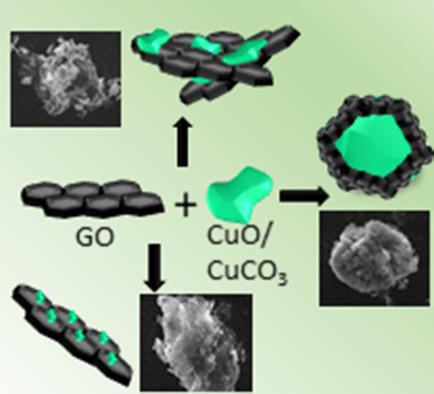当前位置:
X-MOL 学术
›
ChemSusChem
›
论文详情
Our official English website, www.x-mol.net, welcomes your feedback! (Note: you will need to create a separate account there.)
Utilizing Cyclic Voltammetry to Understand the Energy Storage Mechanisms for Copper Oxide and its Graphene Oxide Hybrids as Lithium-Ion Battery Anodes.
ChemSusChem ( IF 8.4 ) Pub Date : 2019-12-09 , DOI: 10.1002/cssc.201902784 Cameron Day 1, 2 , Katie Greig 1 , Alexander Massey 1 , Jennifer Peake 1 , David Crossley 1 , Robert A W Dryfe 2, 3, 4
ChemSusChem ( IF 8.4 ) Pub Date : 2019-12-09 , DOI: 10.1002/cssc.201902784 Cameron Day 1, 2 , Katie Greig 1 , Alexander Massey 1 , Jennifer Peake 1 , David Crossley 1 , Robert A W Dryfe 2, 3, 4
Affiliation

|
Graphene-based materials have been extensively researched as a means improve the electrochemical performance of transition metal oxides in Li-ion battery applications, however an understanding of the effect of the different synthesis routes, and the factors underlying the oft-stated better performance of the hybrid materials (compared to the pure metal oxides) is not always demonstrated. For the first time, we report a range of synthetic routes to produce graphene oxide (GO)-coated CuO, micro-particle/GO "bundles" as well as nano-particulates decorated on GO sheets to enable a comparison with CuO and its carbon-coated analogue, as confirmed using scanning electron microscopy (SEM) imaging and Raman spectroscopy. Cyclic voltammetry was utilized to probe the lithiation/delithiation mechanism of CuO by scanning at successively decreasing vertex potentials, uncovering the importance of a full reduction to Cu metal on the reduction step. The GO hybrid materials clearly show enhanced specific capacities and cycling stabilities comparative to the CuO, with the most promising material achieving a capacity of 746 mAh g-1 and capacity retention of 92 % after 30 cycles, which is the highest stable capacity quoted in literature for CuO. The simple cyclic voltammetry technique used in this work could be implemented to help further understand any conversion-type anode materials, in turn accelerating the research and industrial development of conversion anodes.
中文翻译:

利用循环伏安法了解作为锂离子电池阳极的氧化铜及其氧化石墨烯杂化物的储能机理。
石墨烯基材料已被广泛研究,以改善锂离子电池应用中过渡金属氧化物的电化学性能,但是,对不同合成路线的影响以及通常被认为具有更好性能的因素的理解杂化材料(与纯金属氧化物相比)并不总是被证明。首次,我们报道了一系列合成路线,这些路线可生产氧化石墨烯(GO)涂层的CuO,微粒/ GO“束”以及装饰在GO板上的纳米颗粒,从而可与CuO及其碳进行比较涂覆的类似物,如使用扫描电子显微镜(SEM)成像和拉曼光谱法所证实的。循环伏安法用于通过依次降低顶点电势进行扫描来探测CuO的锂化/脱锂机理,从而揭示了在还原步骤中完全还原成Cu金属的重要性。与CuO相比,GO混合材料清楚地显示出更高的比容量和循环稳定性,其中最有前途的材料在30个循环后达到746 mAh g-1的容量和92%的容量保持率,这是文献中引用的最高稳定容量用于CuO。可以实施这项工作中使用的简单循环伏安技术,以帮助进一步了解任何转换型阳极材料,从而加速转换阳极的研究和工业发展。与CuO相比,GO混合材料清楚地显示出更高的比容量和循环稳定性,其中最有前途的材料在30个循环后达到746 mAh g-1的容量和92%的容量保持率,这是文献中引用的最高稳定容量用于CuO。可以实施这项工作中使用的简单循环伏安技术,以帮助进一步了解任何转换型阳极材料,从而加快转换阳极的研究和工业发展。与CuO相比,GO混合材料清楚地显示出更高的比容量和循环稳定性,其中最有前途的材料在30个循环后达到746 mAh g-1的容量和92%的容量保持率,这是文献中引用的最高稳定容量用于CuO。可以实施这项工作中使用的简单循环伏安技术,以帮助进一步了解任何转换型阳极材料,从而加速转换阳极的研究和工业发展。
更新日期:2020-01-23
中文翻译:

利用循环伏安法了解作为锂离子电池阳极的氧化铜及其氧化石墨烯杂化物的储能机理。
石墨烯基材料已被广泛研究,以改善锂离子电池应用中过渡金属氧化物的电化学性能,但是,对不同合成路线的影响以及通常被认为具有更好性能的因素的理解杂化材料(与纯金属氧化物相比)并不总是被证明。首次,我们报道了一系列合成路线,这些路线可生产氧化石墨烯(GO)涂层的CuO,微粒/ GO“束”以及装饰在GO板上的纳米颗粒,从而可与CuO及其碳进行比较涂覆的类似物,如使用扫描电子显微镜(SEM)成像和拉曼光谱法所证实的。循环伏安法用于通过依次降低顶点电势进行扫描来探测CuO的锂化/脱锂机理,从而揭示了在还原步骤中完全还原成Cu金属的重要性。与CuO相比,GO混合材料清楚地显示出更高的比容量和循环稳定性,其中最有前途的材料在30个循环后达到746 mAh g-1的容量和92%的容量保持率,这是文献中引用的最高稳定容量用于CuO。可以实施这项工作中使用的简单循环伏安技术,以帮助进一步了解任何转换型阳极材料,从而加速转换阳极的研究和工业发展。与CuO相比,GO混合材料清楚地显示出更高的比容量和循环稳定性,其中最有前途的材料在30个循环后达到746 mAh g-1的容量和92%的容量保持率,这是文献中引用的最高稳定容量用于CuO。可以实施这项工作中使用的简单循环伏安技术,以帮助进一步了解任何转换型阳极材料,从而加快转换阳极的研究和工业发展。与CuO相比,GO混合材料清楚地显示出更高的比容量和循环稳定性,其中最有前途的材料在30个循环后达到746 mAh g-1的容量和92%的容量保持率,这是文献中引用的最高稳定容量用于CuO。可以实施这项工作中使用的简单循环伏安技术,以帮助进一步了解任何转换型阳极材料,从而加速转换阳极的研究和工业发展。



























 京公网安备 11010802027423号
京公网安备 11010802027423号